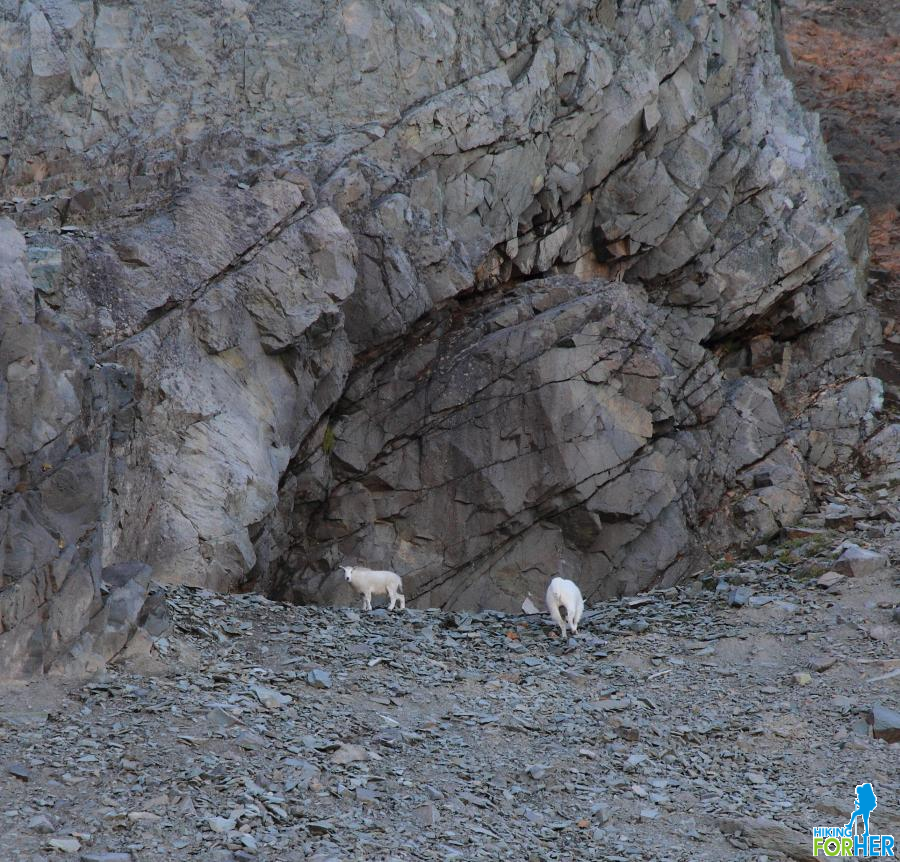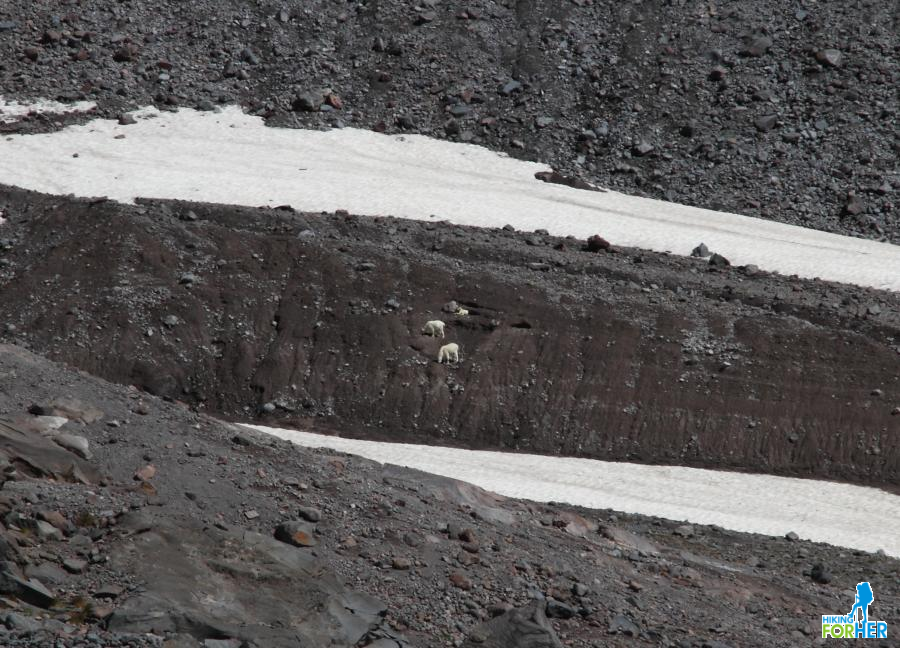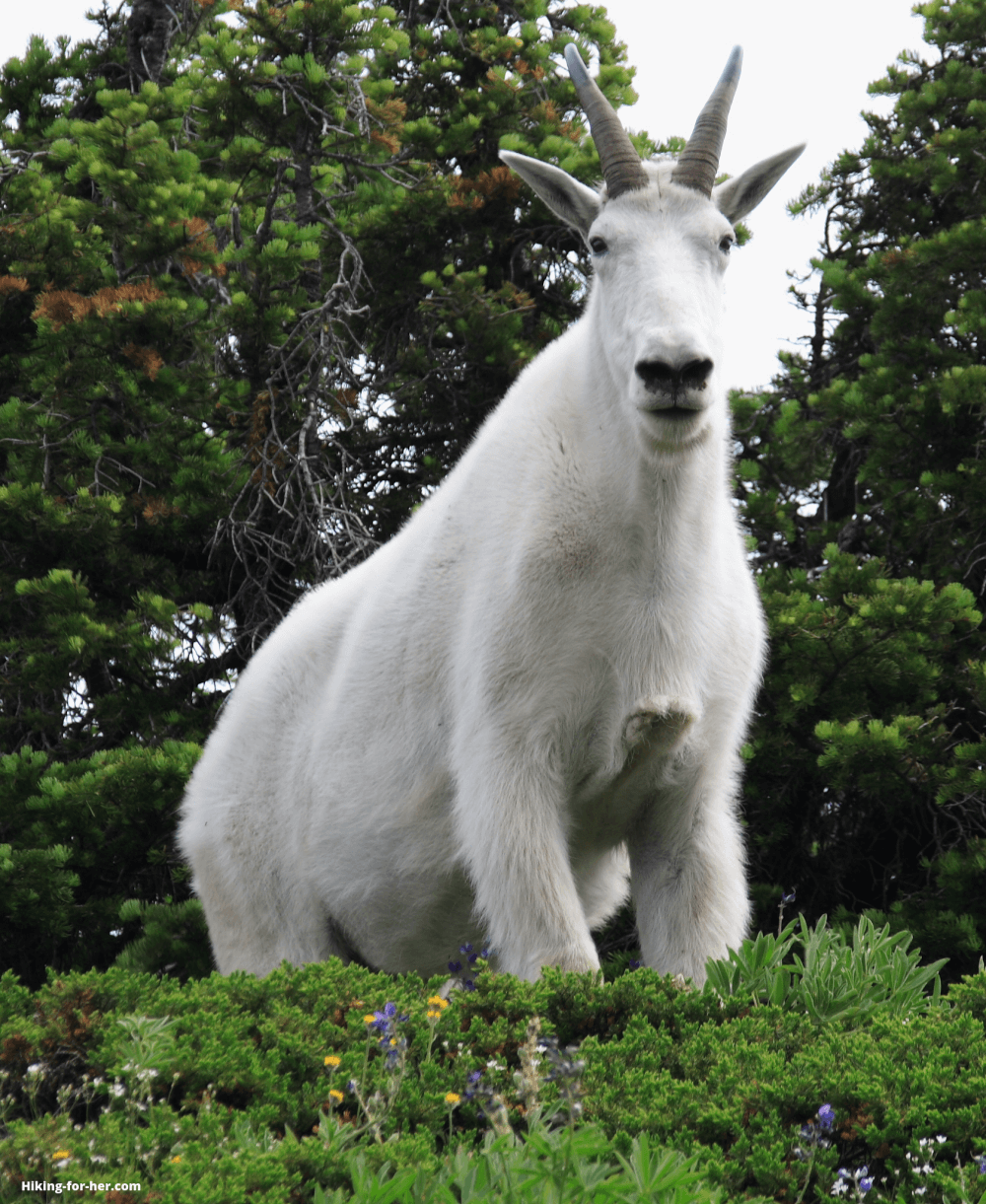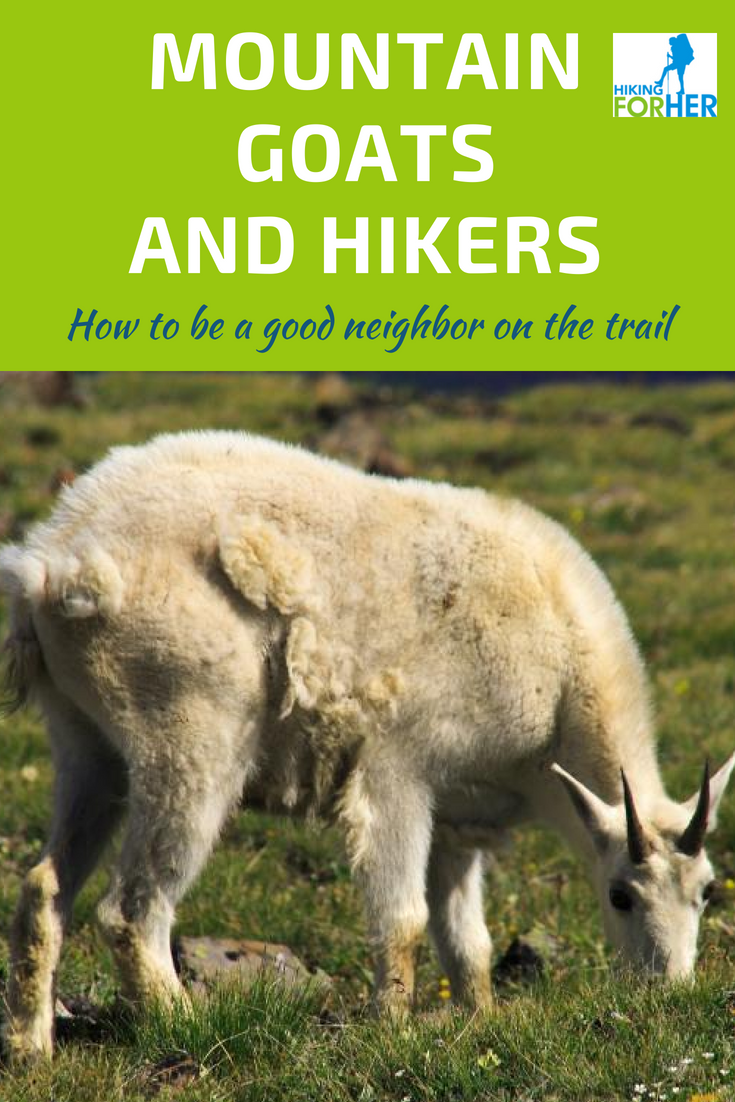
Mountain Goats And Hikers:What To Know
Before You Spot One On The Trail
By Diane Spicer
Mountain goats and hikers both love amazing alpine vistas.
For hikers, it's about photo ops and a feeling of freedom.
For goats, it's protection from predators.
So what should you do when you're heading into known mountain goat territory?
Use Hiking For Her's three step mountain goat awareness plan.
But first, a few facts about mountain goats so you can appreciate why the three step approach is a good thing to know as a hiker.
Mountain goat habitat
These rugged, sturdily built animals are found in the western mountainous areas of the United States (Cascade Range and Rocky Mountains) and British Columbia, Alberta and Yukon.
They are also found in the Chugach Mountains and southeast regions of Alaska.
As you can see, the rockier the habitat, the better for these nimble mammals.
 Mount Rainier National Park's mountain goat alpine terrain. Mom (nanny) has shooed her offspring (kid) up to even more inaccessible rocky ground, and is moving up to join it.
Mount Rainier National Park's mountain goat alpine terrain. Mom (nanny) has shooed her offspring (kid) up to even more inaccessible rocky ground, and is moving up to join it.For more facts about mountain goats, including how to refer to males, females and babies - and why they're not really goats, read this.
As summer gets into full swing, the goats will wander around alpine terrain, looking for vegetation and resting spots.
This can bring them down into treeline areas.
And that's when hikers will get an up close and personal view of them.
- It's best if you have a plan for when mountain goats and hikers share the trail.
Mountain goats and hikers: what's a normal interaction?
A herd of mountain goats should have no interest in a close approach to humans.
In fact, they should loathe you!
Their instinct tells them you're a predator, and they should turn tail -literally- and move away from you (see photo above).
It's likely they will have a rocky escape route, and it's fascinating to watch them use it.
- Even the kids, with their tiny stubby legs, will have no hesitation to scramble up or down a rock face.
Mountain goats and hikers: what's the attraction?
As more and more hikers take to the trails in subalpine or higher elevations, mountain goats get used to human smells and behaviors.
Human urine is salty, and hikers who pee on or near trails are encouraging goats to come onto the trail for a closer look (or a salt lick, to be honest).
Here's how you can pay it forward for the hikers who will follow you:
- Urinate way, way off the trail at treeline.
- Pee on snow and sun exposed rocks (or better yet, dirt around rocks) above treeline, areas with the highest chance of fast evaporation.
Sweaty hiking shirts, salty boots, sweat encrusted socks - yummy to a mountain goat who is craving salt!
Hikers who share food with these "cute" animals are training them to associate humans with food, a dangerous precedent. So just don't.
Any goat who is taking an abnormal interest in you has had its behavior shaped by previous human encounters.
It's likely that it's a male goat who wants what you have. I've never had a nerve wracking encounter with a female.
- Speaking of size, male goats can reach 300 pounds and 3+ feet in height.
And during mating season (late fall, early winter), he wants you to get far, far away from his harem.
- He'll be willing to get belligerent to get his point across to any hiker who strays into his territory.
Mountain goats and hikers: have a safety plan
There are three things you can do, and of course it all depends upon what reaction you get from the mountain goats.
- Take these tips as baseline knowledge about mountain goats and hikers.
If they are not habituated to humans, your presence is enough to move a herd of goats away from you.
Your natural instinct to make noise and shoo them away should do the trick if you surprise them, although it's highly unlikely to catch a mountain goat napping near a trail.
And in fact, they may start moving away from you well before you even spot them.
- Their keen eyesight is one of their best defenses.
- And if they don't associate the smell of sweat with salt, they think you stink.
But it's smart to be prepared to know how to take more aggressive actions to get them to move away from you and go back to doing goat-ish things.
- When the universes of mountain goats and hikers collide, it's up to you to do the safest thing you can.
Step One: be pre-emptive
Keep an eye on trail reports for bad behavior from resident goats.
If there is a problem in a national park, chances are it will be posted and trail closures might occur.
Never ignore a trail closure.
- It's not worth it to hike into an area where a large mammal such as a mountain goat or a bear has exhibited problematic behaviors.
- Becoming a statistic is not what you want from your trail time.
You can also monitor your favorite social media posts on Twitter, Instagram, Facebook or anywhere hikers share photos of recent hikes.
- If selfies with mountain goats are showing up, maybe you should avoid that particular area until things calm down.
If you make it a habit to hike in mountain goat terrain, watch for clues about their presence and preferences.
- Clumps of dirty white goat fur waving like little flags from vegetation
- Scat: little brown turds in a scattered pattern, to be precise
- Goat wallows: shallow depressions in bare dirt on ridges or around boulders, where goats rest or sleep
- Fresh hoof prints on trails
Knowing that you share the area with goats will keep you alert.
However, most goats will be hanging out in areas like this one:
 Mountain goats doing their grazing thing far, far away from the trail
Mountain goats doing their grazing thing far, far away from the trail
Step Two: evasive action
Now let's think about a realistic hiking scenario, and what you can do.
A mountain goat has spotted you, and instead of yielding the trail to you, it starts approaching.
This is your first inkling that you're going to have to discourage an interaction.
If you can backtrack safely and quickly, without running or panicking, do so. In my experience, the goat has a magic "zone" beyond which it will not stray.
It's your job to get past that invisible but real line.
If that's not an option, wave your hiking poles and make very loud, human noises.
If the goat isn't interested in aborting its mission to come in for a close look at you, your heart rate will go up.
Those sharp horns look menacing when paired with the stare of a male mountain goat!
But turn that adrenaline rush into action.
- Don't split up if you're in a group.
- Stay close together and present a united front.
- Don't panic, don't run, don't sit down.
- Walk calmly away from the goat, together, without turning your back if at all possible.
- If you can quickly take off a layer of clothing, use it as a flapping, confusing and hopefully frightening to a goat, extra margin of safety.
Step Three: defend
 Way, way too close!!!
Way, way too close!!!If the goat comes into your personal space, it's time to get defensive.
To keep the goat at bay, talk to it in a loud, commanding voice. No pleading!
I have had to do this several times, and it's nerve wracking, but at least in my case, effective.
I have also thrown big rocks at the feet of a goat who just wouldn't take no for an answer.
The flanks (sides) and back end (rear) of the goat are also suitable targets for tossing stones.
- This seems a bit desperate, but remember, it's likely you'll be in rocky alpine terrain (lots of loose rocks) when you meet Mr. Goat.
Mountain goats and hikers are a bad combination if the goat becomes aggressive or overly curious, because only one of them has horns.
- So use what you have ready to hand to exhibit behaviors that communicate your status as a human.
There is one big exception
If you've walked away from your hiking gear and extra clothing, and a goat has come to investigate, game over.
Your best move: Hunker down and out-wait its interest in your sweaty stuff.
Don't try to scare it off, just be patient.
After it licks and/or chews what it wants, it will move off.
- This can take awhile, trust me. Craving salt is a strong drive (maybe you can relate).
Which explains why I now avoid walking very far away from my gear when I'm in goat territory.
My stuff, my sweat.
Mountain goats and hikers can learn from each other, right?
Questions about these
mountain goat safety tips?
Mountain goats and hikers can co-exist.
It's up to you as a hiker to make sure that happens peacefully.
These safety tips are not meant as rock solid advice about goat encounters.
Instead, use them to begin thinking about how to react when a mountain goat starts toward you.
- Use common sense and your own good judgment when the time comes.
The Forest Service (U.S. government) has a good video on how to hike safely around goats.
Now that you have some facts about mountain goats, maybe it's time to think about bear awareness.
Home page > Best Hiking Tips >
Mountain Goats And Hikers Safety Tips
|
I get emails all the time about what I wear, eat, carry and love to use on the trail. That's
why I provide affiliate links to you: the best gear that I use myself and have seen used by other hikers is instantly
available for your consideration, and the gear company sends a few
pennies per dollar to this reader-supported hiking website. There is no added cost to you! Everyone ends up a winner: Great gear for you, strong gear companies, and more free hiking tips for everyone. Thanks very much for your support. It's warmly and sincerely appreciated. It also helps send these hiking tips to all your virtual trail buddies around the globe. |
 |


